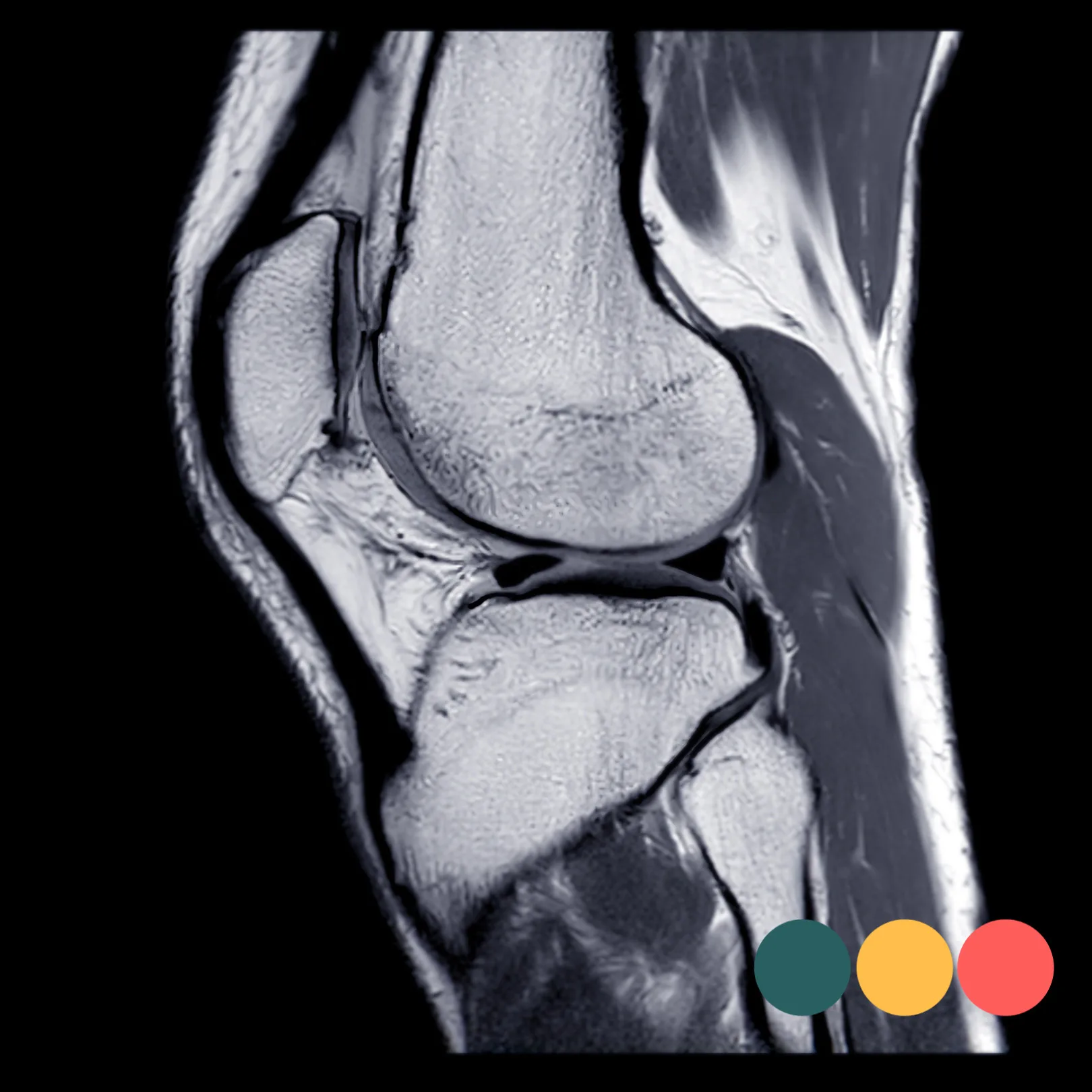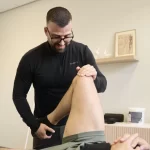Instantly recognise the signs of an anterior cruciate ligament injury
It happens in a split second. You land incorrectly after a jump or make an uncontrolled spin. Suddenly, you hear a snapping sound followed by a sharp pain in your knee. As an athlete, you actually already know, this doesn't feel right. You may have injured your anterior cruciate ligament. In the medical world, we call this an anterior cruciate ligament rupture, a high-impact sports injury. At Fysio Fitaal in Tilburg we have a lot of experience in treating anterior cruciate ligament injuries, in this article we will explain to you how to recognise this injury and what you can do to ensure the best possible recovery.

The function of the anterior cruciate ligament
The anterior cruciate ligament is very important in the stability of your knee. This ligament runs diagonally through the heart of your knee joint and connects your thighbone(femur) to your shinbone(tibia). The ligament has three larger functions that are crucial for sports performance. The anterior cruciate ligament prevents your tibia from sliding too far forward. Second, it controls the rotational movements of your knee, essential in all sports that require you to change direction. The third function is what we call proprioceptive. The anterior cruciate ligament contains nerve tissue and sensors that transmit information to your brain about the position, movement and tension in your knee. This allows your body to know how far you can bend your knee, how hard you push off or when to correct while landing or turning.
An intact anterior cruciate ligament continuously provides feedback to your central nervous system, keeping your movements fluid and stable without you having to consciously think about it. This also explains why athletes with an anterior cruciate ligament injury often feel insecure, even when strength has recovered sufficiently.
How does a cruciate ligament injury occur?
An anterior cruciate ligament injury occurs during the most natural movements. We know that about seventy per cent occur without any contact with an opponent. So it is not the hard tackle that causes this injury, but rather that very movement you have made thousands of times before. The riskiest situation is what we call a cutting manoeuvre. You are running hard and suddenly decide to change direction. You put your foot firmly on the ground to transfer forces, while your upper body is already turning to the new direction. At that key moment, the forces are too great in the knee and it crosses a physiological boundary. Your knee makes an unnatural movement, the load becomes too great and the anterior cruciate ligament is damaged.
Another well-known scenario is landing incorrectly after a jump. You jump up as always but on landing this time things go wrong. You land with an overextension of the knee or land just a little bit diagonally on your foot which ultimately puts the knee in an unnatural position. We know that female athletes are at significantly higher risk of this injury. Sometimes as much as two to eight times higher than male athletes.
The first signs of an anterior cruciate ligament injury
The moment itself is undeniable. Myself and several colleagues unfortunately know this moment personally. A moment that athletes instantly recognise and that is etched in the memory of many. It usually starts with that sound, a distinct "pop" or "crack" that not only you hear, but sometimes teammates and spectators as well. About 50 per cent of athletes hear this characteristic sound during this injury.After that sound, pain follows. This is not a nagging pain that you can easily bite away. It is a deep, sharp pain that immediately makes it clear that something is wrong.
Within seconds, you notice that your knee is no longer functioning properly. It feels unstable, as if you cannot fully rely on it. Many try to take another step, but notice that the leg no longer does what you are used to. With an anterior cruciate ligament injury, swelling occurs very quickly because the cruciate ligament is richly perfused with small blood vessels that are also damaged when torn. This causes immediate bleeding into the joint cavity, with the joint filling with blood within hours instead of the gradual inflammation that occurs with other injuries. Due to the limited space of the capsule, you feel a pressure in the knee. These acute symptoms often start within 30 minutes to 2 hours of the time of injury, making swelling much faster and more noticeable than with other knee injuries.
Immediately after anterior cruciate ligament injury
Immediately after an anterior cruciate ligament injury, it is important to relieve the knee at least for a short period of time. The adrenaline can make you feel less and put unnecessary strain on the knee. In a controlled environment, this won't hurt. But when you still try to resume your sporting activities with a torn anterior cruciate ligament, it can be dangerous and the chances of damaging other structures in the knee increase unnecessarily.
Cooling is common for pain relief. Ice in a towel for about 15 to 20 minutes can help, but do not do this too long after the initial pain has subsided. Constriction of blood vessels reduces the natural inflammatory process needed for healing. A compression bandage can help, but make sure it is not too tight so that your fingers and toes remain normal in colour.
Elevating your leg is highly recommended, though, to reduce fluid and bleeding faster. Put your leg up on pillows so that your knee is higher than your heart. This may feel uncomfortable, but helps your body drain excess fluid and blood more effectively.
When not to wait to seek help
Certain signs require immediate medical attention. Go immediately to the emergency room in case of a markedly deformed knee, complete inability to move your leg(ankle, toes wobble), numbness or tingling in foot or lower leg, blue discolouration of foot or lower leg. These symptoms may indicate serious damage such as damage to blood vessels, nerves or possibly more complex fractures that need immediate attention.
Why contact Fysio Fitaal in Tilburg
It is important to note that a cruciate ligament injury often does not come alone. The trauma can also damage other structures such as the meniscus or structures in the posterolateral corner of your knee. A bucket handle tear of the meniscus can potentially cause lock symptoms where your knee can no longer fully extend or bend. When a bucket handle tear can be diagnosed quickly and sutured through surgery, it gives much better results than cutting away. The success of this operation decreases the more time it takes. This is because the quality of the meniscus decreases the longer it is trapped in the joint space of the knee.
A major misconception we often encounter is that a cruciate ligament injury requires immediate surgery. In reality, the anterior cruciate ligament can always be treated, even months or years after the injury. There are experimental techniques such as the BEAR procedure in which the own cruciate ligament is sutured, but these are almost never used in practice. The focus in the first weeks is therefore not on having to repair the cruciate ligament immediately, but on optimising conditions for possible later treatment. This means maintaining muscle strength and preventing stiffness. But most important is to rule out collateral damage that does require acute attention.
For many athletes, conservative treatment is a good consideration, especially if you are willing to adapt sports activities. Surgery is mainly necessary for athletes who want to return to some level with sports such as football, basketball, handball or tennis.
What happens at your first physiotherapy appointment after an anterior cruciate ligament injury
At Physio Fitaal, we start with a detailed conversation about exactly what happened. Every detail is important: how did your leg stand, did you hear a recognisable pop sound, what did you feel immediately afterwards? This information helps us diagnose and predict the course.
The physical examination that follows is important to make a statement about the integrity of the anterior cruciate ligament. We have specific tests such as the Lachman test, in which the leg is brought forward with a short movement to assess whether the cruciate ligament still inhibits forward translation. In the Lachman test, we assess not only the degree of movement, but also the so-called cord phenomenon. This is the feeling of a cord or inhibition at the end of movement. When the anterior cruciate ligament is intact, you feel this distinct inhibition. A complete tear lacks this cord phenomenon, which is a strong suspicion for a complete cruciate ligament rupture. To assess your knee function, we use standardised criteria such as the IKDC international knee documentation committee score. This science-based method helps us assess passive structures objectively.
As indicated, we also look at other structures in your knee. A cruciate ligament injury rarely comes alone, any meniscus damage and damage to the posterolateral angle should be diagnosed quickly for optimal treatment. In addition to the physical examination, we can use ultrasound as a valuable diagnostic tool. Ultrasound is a suitable tool for detecting collateral damage around the knee. We can assess the following structures, among others: ultrasound can potentially visualise meniscus tears, especially at the edge of the meniscus. Collateral ligaments (lateral ligaments) can be assessed well. Possible damage to the quadriceps, hamstrings or other muscles around the knee. Echo clearly shows any swelling in joint capsules or involvement of bursae.
For the anterior cruciate ligament itself, ultrasound has been less suitable because of its deeper location and complex anatomy. But having said this, there are interesting new developments in this area. Modern equipment makes it increasingly possible to also assess certain aspects of the anterior cruciate ligament, although MRI still remains the gold standard for complete cruciate ligament diagnostics.
Conservative or operative?
Not every cruciate ligament injury requires surgery. For athletes who do not play pivotal sports or are willing to modify their activities, conservative treatment can yield good results. The key lies in systematically building strength around your knee, especially your quadriceps, which can take over some of the stabilising function.
For athletes who want to return to some level of pivotal sports such as football, basketball, handball or tennis, surgery is often the best option. But before you go under the knife, we make sure your knee is as strong as possible. Training under the guidance of Physio Fitaal before your surgery is not a luxury but a necessity for optimal results.

Fysiofitaal is your partner in recovery from an anterior cruciate ligament injury
At Fysiofitaal, we understand that every cruciate ligament injury is unique. We take the time to get to know you, understand your goals, and develop a treatment plan that fits you perfectly. Our team has years of experience dealing with cruciate ligament injuries at all levels, from recreational athletes to professional athletes. We believe in a comprehensive approach where we look not only at your knee, but at you as a total person. Your sports history, lifestyle, goals and fears all play a role in how we interpret your treatment.

Related complaints

Cyclops (arthrofibrosis)
Cyclops also known as arthrofibrosis is caused by scar tissue in the knee often after...

Injury to the posterolateral complex
In an injury where the forces are great enough, there can be actual damage from...

Medial band knee(MCL)
An injury to the inner ligament of the knee requires accurate diagnosis and a...

Meniscopexy (meniscus suture)
When it comes to the meniscus, we know of two techniques that can be used as...
